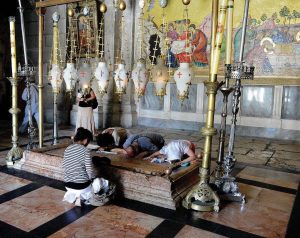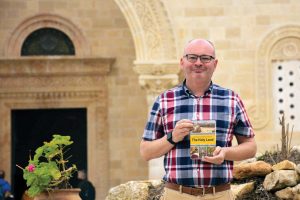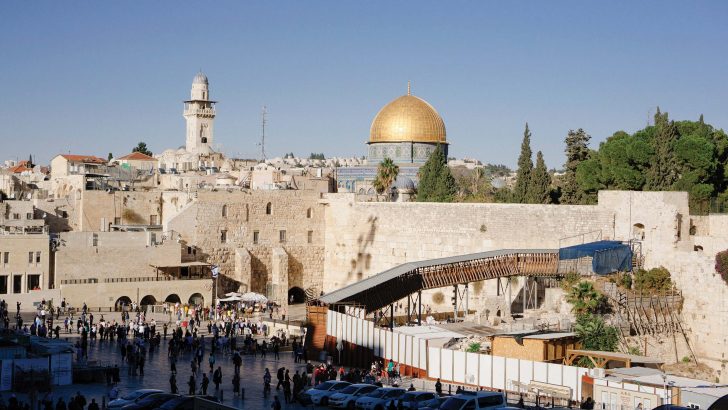The Holy Land is no museum but a place the Faithful can truly experience a deep connection with unique cultures, fascinating history and most importantly, Christ, Chai Brady hears
From the Stone of Unction where Christ was anointed after his crucifixion – where there is contained thousands of years of countless prayers and tears – to the bustling streets and markets of Bethlehem and Nazareth, the Holy Land is certainly awe-inspiring.
Having been to the Holy Land dozens of times it’s impossible to stop author of An Irish Pilgrimage Guide to The Holy Land and Editor of The Irish Catholic, Michael Kelly, from highlighting the significance of the holy sites and how they bring the Gospels alive in a new way for pilgrims.
Asked if he has a favourite place to visit on his pilgrimages there, Mr Kelly says there are many, beginning with the place of Christ’s birth.
He says: “The holy manger in Bethlehem is a beautiful place because of the simplicity of it, because actually there’s a huge simplicity at the heart of the Christian story. People have longed for this King, they longed for this glorious saviour to come and lead them into battle.
“And yet, as always, God contrasts our ideas, and God sends this lowly baby born to a poor couple in an outhouse in this outpost of the Roman Empire.”
Intensity
Mr Kelly contrasts this image with the “intensity” of the city of Jerusalem. “Jerusalem, to me is the centrepiece of the world and one of the things I love to do with the pilgrims – and I talk about this in the book – is to be able to trace the steps of Christ. To be at the top of the Mount of Olives, to be where the Lord was with the disciples after visiting his friends in Bethany – because Bethany is just the other side of the Mount of Olives, where people will remember the Lord raised Lazarus from the dead,” he says.
Pilgrims can also walk down Palm Sunday road and visit the Church of Dominus Flevit along the way, which Michael describes as “really, really beautiful”. The architect of the church and many others, Antonio Braluzzi is also known as the ‘Architect of the Holy Land’. He created, among many others, the pilgrimage churches at the Garden of Gethsemane, on Mount Tabor, on the Mount of Beatitudes, and at the tomb of Lazarus in Bethany.
The Church of Dominus Flevit is crafted in the shape of a tear because it is said this is where the Lord wept over Jerusalem. Close by is another very famous place of sorrow, the Garden of Gethsemane. Mr Kelly says: “We have in the Garden of Gethsemane, the olive trees, some of them 2,000 years old… trees dating back to the time of Jesus. So that’s a beautiful journey for people.”
There is not much travelling involved between many of the sites, with Mr Kelly saying: “Jerusalem is a very, very small city as well. All of these sites are in close proximity, but then when we get into the Old City, we see the other sites associated with that first Holy Week.”
Exercise
However, he says a pilgrimage to the Holy Land is not just an exercise in learning the history of these ancient sites, as “one of the things you have to think about is that people bring so much on a pilgrimage”.
“On a pilgrimage to the Holy Land, they bring so much more because we believe in a God who is no stranger to suffering, we believe in a God who didn’t shy away from suffering. People bring suffering to the Holy Land for sure, they also bring joy, they bring hope, they bring happiness, they bring all of those things, but there’s always sorrow and there’s always suffering, Prophet Isaiah describes the Lord as a man familiar with sorrow,” Mr Kelly says.
High points
“One of the high points is the way of sorrow, the Via Dolorosa, when we retrace the Stations of the Cross. The Old City, it’s a small place. So there’s hustle, there’s bustle there, there’s soldiers, there’s kids trying to go to school, there’s market vendors. I tell the pilgrims to try to think that this is how it was, the whole city of Jerusalem didn’t come to a stop because the latest ‘crazy guy’ from Galilee was being crucified by the Romans.
“The small band of followers of Jesus, most of them as we know, had abandoned him the night before, but the women followed Jesus along the way and I say, ‘we need to be like the women following Jesus along the way’. And we get there to the Church of the Holy Sepulchre, where we can ascend the few steps up to Calvary, we can touch the actual spot where the Lord was crucified.”
Mr Kelly explains that at Calvary there is a “very profound place”: Christ’s empty tomb. Pilgrims can enter Christ’s tomb and experience being inside the place where Christ was left before rising again.

While he admits it’s difficult to judge his absolute favourite place, he says: “One of my favourite places, one of the most moving places for me and I never cease to be moved by it no matter how many times I’ve been there, is right at the heart of the Church of the Holy Sepulchre: the Stone of Unction.
“It is the place where tradition tells us that after the body of the Lord was taken down from the cross, the body was brought to be anointed before then being put in the tomb. So to me, that’s a really, really beautiful place, because that is a place where people bring so much. You can go there any day of the week, morning, noon, and night and you can see people, they have their heads bowed, and they’re kissing it. There are nearly 2000 years of prayers and tears contained in that stone. And if that doesn’t make something holy, I don’t know what does.”
Holy Land Christians
Mr Kelly warns people off thinking the Holy Land is some sort of museum, saying it is full of modern cities with people living alongside ancient sites of huge religious significance. Within these cities, the Christian population faces extinction. He says: “One of the things that makes me sad is the idea the Holy Land is a museum because there is a danger that it becomes a museum.
“We’ve spoken about the Byzantine periods, Mameluke periods, Crusader periods, but actually the most important stones in the Holy Land are what we call the living stones, what are the living stones? The living stones of the Holy Land are the Christian community, the tiny Christian community who make up only about 3% of the population. They are a community under pressure, because many of them are leaving, many of them are feeling the tension around the Israeli-Palestinian conflict.
“The economic disaster that Covid has been for the Christian community in the Holy Land has just been catastrophic. Many, many of the younger people in particular are leaving, and what would the Holy Land be without a Christian community? It would be a museum.”
Christians in the Holy Land are given a special focus in the book and are also a special focus on the pilgrimages he brings to the Holy Land. Mr Kelly says the pilgrimages are not just aimed at visiting sites; showing solidarity with the embattled Christian community is also a huge part.
“We make material financial contributions,” Mr Kelly says. “We also help some parishes here in Ireland twin with parishes in the in the local community. They really, really are a community under pressure. When you look at a city like Bethlehem, not very long ago the majority of the people were Christians, now the Christian community, at the last count about 12 years ago, was about 11%. Now, actually, none of the Christians want a census because they’re really worried what the results are going to be”.
Appeal
“So I would really appeal to people, even if you can’t come to the Holy Land – because the first thing I would say is do come to spend time there and be there with the Christian community – pray for the Christian community, pray that those living stones will stay because what is the Holy Land to us without them? They are the descendants of the first people to hear the message of Jesus.”
Mr Kelly says it’s beautiful to be able to visit the Christian school in Jericho and see boys and girls being educated there and to know that they are Christian today because 2,000 years ago someone in their family decided to follow Christ.
Anxious
Mr Kelly says he encounters people who are apprehensive about the idea of going, perhaps because they feel it’s far away – off in the Middle East. Regarding advice to those who are anxious, Mr Kelly says: “People are maybe used to going places like Rome and Medjugorje, but they think that the Middle East is that one bit farther away. I would say be calm because you’re entering a different world, you’re entering the world of the Lord.
“How can you not love the Holy Land? It’s the land of Jesus, the land where God chose to be born. And I would say, come and experience everything that it has to offer, you will go a long way to meet a friendlier, more welcoming, more open people.”

The book also focuses on culture and food, which Mr Kelly firmly believes people will also fall in love with. “Sometimes it is interesting hearing people at Dublin Airport, they’ll say, ‘Do they have Barry’s tea there?’ And I’ll say, ‘No, they don’t have Barry’s’. They’ll say, ‘Oh, it’s Lyons then?’, ‘No, they don’t have any Lyons either’. I’ll say, ‘But you know, I think you’ll be satisfied if you push yourself a little bit.’
“And actually some of the people who are the most apprehensive about the food at the beginning of the pilgrimage are the people who are going home with the biggest suitcases, because they have packed their suitcases full of dates, flatbread, full of all the wonderful local, freshly produced fruit and veg that is there for people. Give yourself to the food, the food is a wonderful experience. As a produce, it grows quite precisely because they get so much sun. They have become so innovative there about the use of water and irrigation as well. They get beautiful, beautiful, fresh products that we actually don’t get here. I would say to people don’t be apprehensive, take that leap, it’s a trip of a lifetime. You won’t regret it and you will be rewarded,” he added.
While it would be impossible to explore all the sites in one article, Mr Kelly’s encyclopaedic knowledge of the Holy Land certainly explains the richness of the book he wrote – there is much to know about the Holy Land and its history.
Mr Kelly first went to the Holy Land when he was just 18 and immediately fell in love, finding it “absolutely intoxicating”. Asked about his inspiration to write the pilgrimage guide, Mr Kelly says it is based on his experience of going to the Holy Land on multiple occasions, being there by himself, with family members and with pilgrims, adding that “it is a place that I have a great love for and somewhere that I really wanted to try and encapsulate in order to share that love with people”.
An Irish Pilgrimage Guide to The Holy Land by Michael Kelly is published by Columba Books and is available in bookshops as well as from columbabooks.com, priced at £14.99/€16.99. Mr Kelly will lead two pilgrimages to the Holy Land in October, for more information call 01 878 8159 or 028 956 80005 or by email: info@marian.ie


 Chai Brady
Chai Brady Jerusalem.
Jerusalem. 